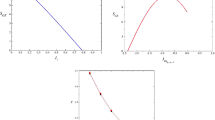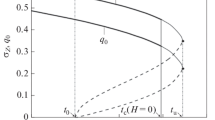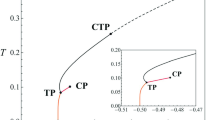Abstract
We have studied some ferroquadrupolar phases of the S = 1 Heisenberg model with bilinear and biquadratic exchange interactions on the square lattice up to the second nearest neighbor, using the SU(3) Schwinger bosons formalism in a mean field approximation. This technique is very convenient to treat nematic order. This technique has the advantage of using the fundamental representation of the SU(N) group instead of SU(2), designed to capture spin-quadrupolar order in addition to the dipolar magnetic order. We also present quadrupole structure factors that can be measured in future experiments. Our calculations can have implications in the study of iron-based superconductors.





Similar content being viewed by others
References
Z. Wang, W.J. Hu, A.H. Nevidomskyy, Phys. Rev. Lett. 116, 247203 (2016)
F. Wang, S.A. Kivelson, D.H. Lee, Nat. Phys. 11, 959 (2015)
R. Yu, Q. Si, Phys. Rev. Lett. 115, 116401 (2015)
C. Fang, H. Yao, W.F. Tsai, J.P. Hu, S.A. Kivelson, Phys. Rev. B77, 224509 (2008)
A.L. Wysocki, K.D. Belashchenko, V.P. Antropov, Nat. Phys. 7, 485 (2011)
R. Yu, Z. Wang, P. Goswami, A.H. Nevidomskyy, Q. Si, E. Abrahams, Phys. Rev. B86, 085148 (2012)
C. Luo, T. Datta, D.X. Yao, Phys. Rev. B93, 235148 (2016)
C. Lacroix, P. Mendels, and F. Mila.( Eds.) Introduction to Frustrated Magnetism (Springer, Berlin, 2011).
H.-H. Lai, W.-J. Hu, R. Yu, Q. Si, Phys. Rev. Lett. 118 (2017) 176401.
Q. Wang, Y. Shen, B. Pan, X. Zhang, K. Ikeuchi, K. Iida, A.D. Christianson, H.C. Walker, D.T. Adroja, M. Abdel-Hafiez, X. Chen, D.A. Charev, A.N. Vasiliev, J. Zhao, Nat. Commun. 7, 12182 (2016)
K. Penc, A.M. Lauchli, in Introduction to Frustrated Magnetism, ed. by C. Lacroix, P. Mendels, F. Mila (Springer, Berlin, 2011) pp.331–362.
N. Papanicolaou, Nucl. Phys. B 305, 367 (1988)
H.T. Wang, Y. Wang, Phys. Rev. B71, 104429 (2005)
A.S.T. Pires, M.E. Gouvea, Eur. Phys. J. B44, 169 (2005)
A.S.T. Pires, L.S. Lima, M.E. Gouvea, J. Phys. Condens. Matter 20, 015208 (2008)
A.S.T. Pires, M.E. Gouvea, Physica A 388, 21 (2009)
A.S.T. Pires, Physica A 373, 387 (2007)
A.S.T. Pires, B.V. Costa, Physica A x388, 3779 (2009)
L.S. Lima, A.S.T. Pires, Solid State Commun. 149, 269 (2009)
A.S.T. Pires, Physica A390, 2787 (2011)
A.S.T. Pires, Solid State Commun. 152, 1838 (2012)
T.A. Toth, A.M. Lauchli, F. Mila, K. Penc, Phys. Rev. Lett. 105, 265301 (2010)
A. Smerald, N. Shannon, Phys. Rev. B88, 184430 (2013)
Y. Kuramoto, H. Kusunose, A. Kiss, J. Phys. Soc. Jpn. 78, 072001 (2009)
L.J.P. Ament, M. van Veenendaal, T.P. Devereaux, J.P. Hill, J. van den Brink, Rev. Mod. Phys. 83, 705 (2011)
Z. Zhang, K. Wierschen, I. Yap, Y. Kato, C.D. Batista, P. Sengupta, Phys. Rev. B87, 174405 (2013)
S.S. Gong, W. Zhu, D.N. Sheng, K. Yang, Phys. Rev. B 95 (2017) 205132.
Acknowledgments
This work was partially supported by Conselho Nacional de Desenvolvimento Científico e Tecnológico (CNPq).
Author information
Authors and Affiliations
Corresponding author
Appendix A
Appendix A
Let us start with the calculation of the spin-spin correlation function. Using <t z > = t in Eq. (9) and Fourier transforming, we have
Then we can write
Taking Eq. (14) into Eq. (A2), we obtain
Using the well know expression
leads to
Finally, inserting Eq. (15) into Eq. (A5), we get Eq. (27).
Now, we turn to the calculation of the zz quadrupole structure factor. Equations (30) and (9) leads to
Let us consider the first term as an example. Using Eq. (14), we find
Using the standard procedure to decouple the four operators terms
and taking into account that the only non null averages are <α + α > , < αα + > , <β + β > , and <ββ +>, we get
That can be written as
On the other side, the fourth term leads to
Putting all the terms together, we find at T = 0:
Eq. (15) gives
and
Inserting (A13) and (A14) into (A12) and using \( {\Lambda}_k^2-{\omega}_k^2={\Delta}_k^2 \), we get Eq. (30).
Finally, we calculate the xy component of the quadrupole structure factor. We start with
Using Eq. (9) and taking the Fourier transform, we obtain
We follow the same procedure as we did for the zz component. The calculation is lengthy, but straightforward.
Rights and permissions
About this article
Cite this article
Pires, A.S.T. Ferroquadrupolar Order in the Spin-1 Bilinear-Biquadratic Model up to the Second Nearest Neighbor. Braz J Phys 47, 481–487 (2017). https://doi.org/10.1007/s13538-017-0516-x
Received:
Published:
Issue Date:
DOI: https://doi.org/10.1007/s13538-017-0516-x




